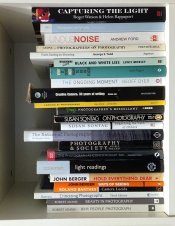What Photography Is - James Elkins
Back in December 2013 I made a trip to the emergency room of the local hospital because I was experiencing angina. Handy foresight allowed me to grab a copy of James Elkin's
"What Photography Is" that I had recently ordered as a followup to his book
"What Painting Is." I thoroughly enjoyed the latter work in which he compared Painting to Alchemy and thought I might be in for a similar amusement with the book on Photography. Not so.
"What Photography Is" begins as a critique of Barthe's
"Camera Lucida" and ends up being a somber interpretation of the medium. It focuses on photography not as art or on its vernacular function in supporting memory and emotion, but as being a medium that allows us to perceive things that normally do not register via our human visual system. Technical photography such as that produced in photographing nuclear explosions, photomicrographs, etc., is discussed. Elkins not only dwells upon what is normally impossible for us to see, but also what is impossibly hard to look at.
His prime example of the latter class are rare and generally suppressed photographs taken of the antiquated (and now banned) Chinese execution method known as
Lingchi or
"Death By One Thousands Cuts" reserved for only the most heinous capital criminals and fomenters of sedition. (I'll leave it to the readers to investigate the details of this gruesome torture should they wish further elucidation.) The practice of
Lingchi was also mentioned by Sontag in
"Regarding the Pain of Others" (2003) as this article (
http://www.theguardian.com/theobserver/2003/aug/03/society) relates:
"Sontag blames the eyes' indiscriminate lust, claiming 'the appetite for pictures showing bodies in pain is as keen, almost, as the desire for ones that show bodies naked'. Her book, unillustrated, caters to neither hunger (though she does tantalisingly describe a photograph that obsessed the perverse philosopher Georges Bataille, in which a Chinese criminal ... [being executed] rolls his eyes heavenwards in transcendent bliss)."
Elkins, Barthes, and Sontag with a bit of the early surrealist Bataille included. Whew! In ER, reading this critical mix while awaiting a determination as to whether I were to have my chest ripped open in a few hours
Lingchi-like, I found it quite surreal, synchronistic, and alarming when I overheard the attending ER night shift nursing staff debate whether they would be ordering "Chinese" take-out for dinner. However, that experience was not quite as surreal as my earlier ER adventure 10 years beforehand when I lay prostrate on that cold cardiac cath lab table as Eminem emanated through the overhead speakers:
"that'll jumpstart my heart quicker than a
shock when I get shocked at the hospital by the doctor when I'm not cooperating
when I'm rocking the table while he's operating (hey!)
you waited this long now stop debating 'cause I'm back,
I'm on the rag and ovulating
I know that you got a job Ms. Cheney but your husband's heart problem's complicating")
I generally enjoy Elkins' work and have several volumes including:
"How to Use Your Eyes;" "Why Art Cannot Be Taught;" "Pictures of the Body ain and Metamorphosis;"
ain and Metamorphosis;" and
"The Object Stares Back:On the Nature of Seeing." But,
"What Photography Is" was not as light reading as the others.







 ain and Metamorphosis;" and "The Object Stares Back:On the Nature of Seeing." But, "What Photography Is" was not as light reading as the others.
ain and Metamorphosis;" and "The Object Stares Back:On the Nature of Seeing." But, "What Photography Is" was not as light reading as the others.